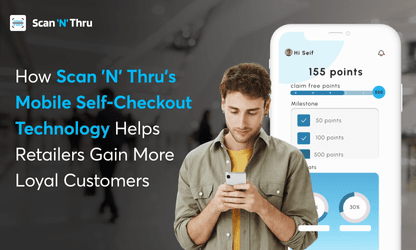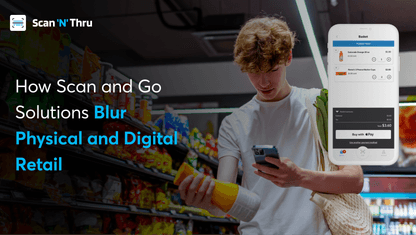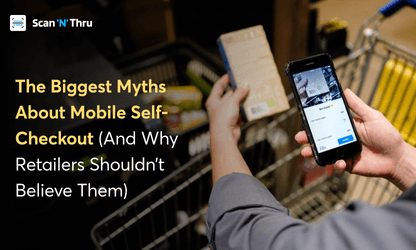There’s a similar unspoken drama that customers witness in almost every retail store: people hovering near self-checkout, weighing their options like they're about to attempt a complex mathematical equation. Some approach with determination, others with visible anxiety.
The hesitation is real, and it's costing retailers like you more than just time—it's eroding the very customer experience technology promised to enhance.
Retail self-checkout had many upsides but in recent years it has also become a source of frustration for many customers whenever they pop up in any retail store. From tech-phobic shoppers to those who fear making mistakes, customer hesitation towards self-checkout reveals deeper narratives about trust, ease of use, and human-technology interaction.
So why is it happening and what retailers like you can do about it? That’s exactly what you’re going to find out in this blog.
You will learn actionable and nuanced strategies that transform self-checkout from a dreaded technological hurdle into a seamless and intuitive experience for your customers.
You'll also explore how mobile self-checkout solutions can revolutionize retail interactions while offering a frictionless approach that naturally aligns with customer preferences and eliminates traditional adoption barriers.
Let’s dive in.
Understanding the psychology behind customer resistance to self-checkout
Understanding the underlying reasons why consumers are reluctant to use self-checkout is crucial to effectively address it. Let’s explore the key factors driving this resistance.
Why do customers hesitate to use self-checkout?
Self-checkout technology often faces pushback from customers due to a combination of usability issues and personal preferences. Here’s a closer look at the main reasons behind this resistance:
Fear of technology or unfamiliarity: If you observe closely, you will notice that for many shoppers—especially older adults or those less familiar with technology—the idea of using a machine instead of interacting with a human cashier can feel daunting. They may worry about making mistakes like scanning items incorrectly or failing to complete the payment process.
Frustration with errors: Technical issues like items not scanning properly, payment errors, or software glitches can disrupt the checkout flow. These problems compound frustration and discourage users from trying self-checkout again.
Feeling rushed or unsupported: Another common concern is the perception of being rushed or unsupported. Without a friendly face to guide them, your customers might feel abandoned or unsure of what to do next. This lack of support can lead to frustration, particularly for those who are in your store for the first time.
Preference for human interaction: Some shoppers simply prefer human interaction. They enjoy the social aspect of chatting with cashiers or receiving personalized recommendations, which self-checkout systems can’t replicate—at least not yet.
Emotional barriers that matter
Beyond practical concerns, emotional factors play a significant role in customer resistance as well:
Anxiety about making mistakes: Anxiety about making mistakes is one of the biggest hurdles. Many shoppers fear they’ll accidentally bypass security tags, trigger alarms, or leave without completing their purchase. This anxiety is especially pronounced for those who aren’t confident with technology.
Lack of trust in automated systems: Some customers worry that self-checkout systems might overcharge them or fail to process payments securely. Why? It’s mostly likely because of a lack of familiarity with how the technology works.
Perceived inconvenience: If the self-checkout process feels slower or more complicated than handing items to a cashier, customers are unlikely to adopt it. Convenience is among the most basic expectations for customers, and anything less won’t meet their expectations.
Real-world insights
In the last couple of years, multiple news reports have emerged regarding retailers moving away from self-checkout stations in their stores.
A July 2024 news report from NBC revealed that some major retailers like Dollar General, Five Below, Target, and Amazon are eliminating self-checkouts from many of their store locations.
The main reasons cited by the companies for this were inventory shrinkage and theft. Apart from that, in a 2023 study by LendingTree, it was found that 21% of consumers feel like self-checkout kiosks make them work for free and 14% worry that it’s replacing cashiers’ jobs.
Shopping experience in self-checkout stores is usually positive but that’s not always the case. Claire Tassin, a retail and e-commerce analyst at Morning Consult says, “People are always complaining about the machines’ being difficult to use or loud or just challenging in some way.”
Retailers like you cannot and should not rely on a system having such mixed reviews and opinions.
Practical strategies to build trust and ease self-checkout adoption
Retail businesses like yours should try the following strategies to gain the trust of customers and boost the adoption of self-checkout technology:
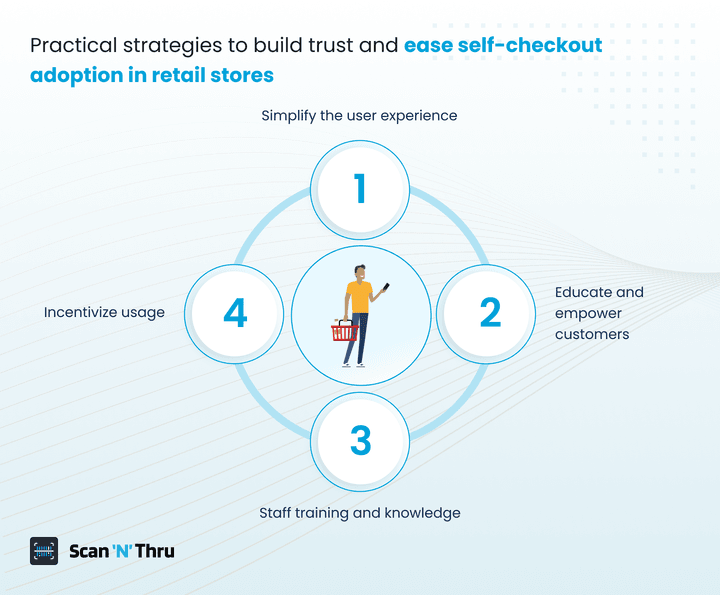
Simplify the user experience
Streamline the interface design: Offer an intuitive interface with clear visuals and step-by-step guidance. Use icons, animations, and prompts to show customers where to scan items or resolve issues like “item not found.”
Reduce checkout steps: Minimize steps by allowing bulk scanning, pre-loaded shopping lists, and quick-payment options like stored credit cards or digital wallets. Every second saved improves the experience.
Ensure system reliability: Maintain consistent performance with regular updates and maintenance. Test frequently to prevent crashes, delays, or technical glitches that frustrate your users.
Provide real-time error resolution: Incorporate tools to resolve errors instantly.
For example:
- Suggest alternatives if an item doesn’t scan.
- Offer live support for unresolved issues.
- Prompt the system to display troubleshooting tips on-screen to guide customers.
By simplifying the process and addressing pain points proactively, you can build trust and encourage adoption.
Educate and empower customers
Education is essential for building confidence among hesitant shoppers. For that, consider providing resources that teach them how to use the system effectively.
For example:
- Create short & engaging tutorial videos demonstrating the checkout process.
- Offer live demos in-store, where your staff members walk customers through the steps.
- Clearly mention and explain the benefits of self-service checkout such as shorter wait times and faster transactions.
Staff training and knowledge
Staff training is equally important. Equip employees to act as “checkout coaches,” which basically means assisting in-store customers during their first attempts or helping customers who are having trouble with the system.
A friendly staff member can reassure nervous users, answer questions, and demonstrate how simple the process really is. Over time, this hands-on support builds trust and encourages repeat usage.
Incentivize usage
Rewards are a powerful motivator for encouraging adoption. Consider offering discounts, loyalty points, or exclusive promotions to your customers who use self-checkout.
For example, you could run a campaign like “Save 10% When You Scan Yourself!” or “Earn Double Points with Mobile Checkout.” Or you can try gamification, which adds another layer of engagement. Try initiatives like “Scan 5 Items and Unlock a Special Reward” to make the experience fun and memorable.
Why mobile self-checkout cannot face customer hesitation
Multiple strong cases can be made in favor of mobile self-checkout technology as to why it’s not likely to face customer resistance or hesitation. Let’s explore it properly:
Advantages of mobile self-checkout over kiosks
Mobile self-checkout systems outperform traditional kiosks in many ways. This technology offers retailers like you a smarter way to meet customer expectations.
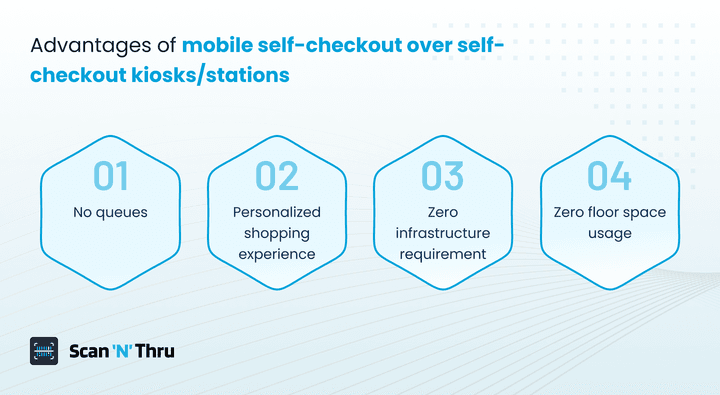
No queues—customers scan as they shop: Traditional self-checkout kiosks still require lines when there’s high foot traffic in your store, which frustrates shoppers. Mobile self-checkout eliminates this entirely because it allows your customers to scan items on their smartphones as they shop. This saves time and enhances customer satisfaction.
Personalized experience tailored to individual preferences: Mobile-based self-checkout apps enable retailers like you to deliver personalized experiences. These systems can help you analyze purchase history and preferences so that you can offer tailored recommendations, discounts, or loyalty rewards.
Reduced dependency on physical infrastructure: Unlike bulky kiosks, mobile self-checkout technology doesn’t require dedicated hardware or floor space in your store. This means you can optimize your store layouts for inventory or experiential zones.
No need for a dedicated checkout area: With mobile self-checkout, your entire store becomes a checkout zone. Shoppers can checkout and pay from anywhere within the store, which streamlines the shopping process and boosts convenience.
Read more - Mobile Based Loyalty Program to Maximize Customer Engagement
Meeting evolving consumer expectations
Consumer preferences have shifted, and mobile self-checkout aligns perfectly with these trends.
Growing preference for contactless interactions post-pandemic: The pandemic accelerated demand for contactless solutions. Mobile self-checkout is perfect for eliminating shared surfaces like kiosk screens, as shoppers use their own smartphones for scanning and payment. This addresses hygiene concerns effectively.
Desire for speed and convenience in shopping: Modern shoppers believe that speed and convenience should be a default. Mobile self-checkout apps align very well with such modern expectations. Your shoppers can bypass lines and complete transactions quickly. Such convenience is equally appealing to busy professionals and multitasking parents alike.
Rising comfort with mobile apps and digital wallets: As smartphone usage grows, so does familiarity with mobile apps and digital wallets like Apple Pay and Google Pay. Integrating these payment methods into mobile self-checkout systems ensures secure, and instant one-tap transactions that tech-savvy customers expect.
How Scan ‘N’ Thru can help retailers
You’ve seen how mobile self-checkout solutions are so much easier to implement and use than checkout kiosks. So if you are looking for a solution that truly works for your business, then here’s how Scan ‘N’ Thru can help you level up your store’s operations and checkout experience:
- Eliminate long queues: Let your customers scan items as they shop and check out directly on their phones—no more waiting in line.
- Boost customer satisfaction: Offer a fast, intuitive, and hassle-free shopping experience that keeps shoppers coming back.
- Gain actionable insights: Access real-time analytics to understand shopper behavior and optimize your store strategy.
- Drive engagement: Use personalized offers, discounts, and loyalty rewards to connect with your customers and increase sales.
- Save on infrastructure costs: Ditch bulky kiosks and dedicated checkout areas, and free up space to reduce your overall expenses.
Final thoughts
The path to self-checkout success in your store isn't paved with technology alone; it's built on understanding the subtleties between customer psychology and innovative solutions. When you recognize hesitation, it’s an opportunity for you rather than an obstacle. By doing that, you've already taken the first step toward transforming your in-store checkout experience.
The strategies we've explored—from understanding psychological barriers to implementing trust-building measures—create a foundation for lasting change. But mobile self-checkout solutions push this even further by offering a familiar interface that speaks your customers' digital language.
The future of retail belongs to those who dare to reimagine convenience. Take this moment to evaluate your checkout strategy. Your customers are ready for change—they're just waiting for you to show them the way. The question isn't whether to evolve, but how soon you'll lead the change.


